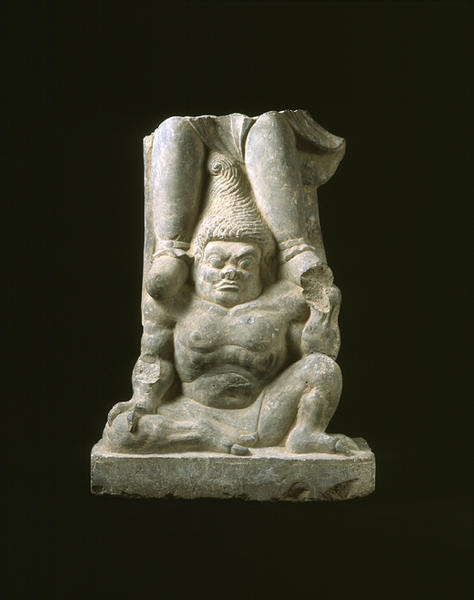天王足部および夜叉
- 火焼洞下出土
- 唐時代
- 石灰石
- H-41.6
- 所蔵
- 龍門石窟研究所蔵
石灰石/火焼洞下出土 唐時代/高41.6 cm/龍門石窟研究所蔵
1988年に火焼洞の南下から出土した。夜叉は左膝を立て、右手を突っ張るようにして、天王を支えている。目を怒らせ、口を引き締め、首が隠れるほどに顎を思いきり引き締めた表情、右膝上に突っ張った右手、立てた左足、肩や胸の写実的な筋肉の表現から、渾身の力を込めて天王を支えている緊張感が伝わってくる。天王は脛[すね]当[あて]を着け、沓[くつ]をはいて、甲[よろい]の下に翻る着衣の端を残しており、均整のとれた颯爽とした風情を伝えてくれる。夜叉の髪を天王の両足の間に渦を巻くように立ち上がらせる表現は、奉先寺洞の南壁東端仏龕内の西壁の天王像にも見られ、制作は7世紀末から8世紀の初頭頃と推定される。
Catalogue Entry
Limestone/ Excavated from the area beneath the Huoshaodong Cave,
Tang dynasty/ H. 41.6 cm/ Longmen Caves Research Institute
This sculpture was excavated from the area beneath the Huoshaodong Cave in 1988. The yaksa, or female demon, has her left knee raised and right hand raised to support the Lokapala. The eyes of the yaksa are fearsome, the mouth is pursed, and the tensed jaw swells to almost completely mask the figure's neck. The realistic depiction of the musculature in the raised right hand, standing left leg, shoulders and chest convey the sense of the strain involved in supporting the body of the Lokapala. Only part of the image of the Lokapala remains. The booted feet, legs bound in leggings and the ends of a garment fluttering beneath armor all show a balanced, gallant pose. The yaksa's hair swirls up into a conical form between the Lokapala's legs. The same hairstyle can be seen on the Lokapala figure on the west wall in the niche at the east end of the south wall of Fengxiansidong Cave. Thus this work is thought to have been created around the end of the 7th or the beginning of the 8th century.
